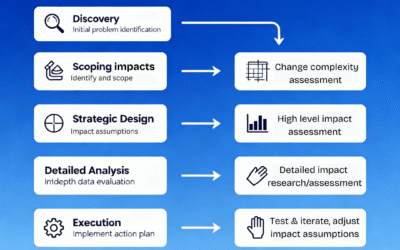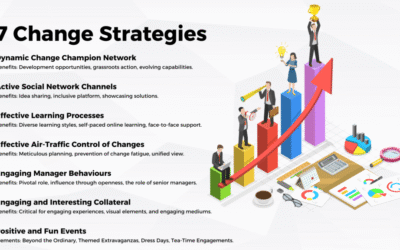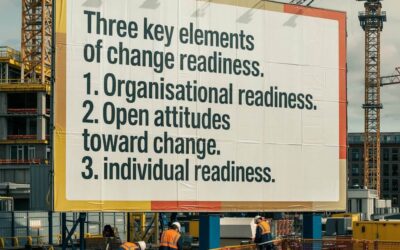Ever since the epidemic began people have started to suffer mental health issues. In fact, according to Harvard Business Review, recent studies have shown that 42% of employees globally have experienced a decline in mental health since the commencement of Covid. This is not a surprise given that governments have routinely locked-down populations to ensure safety and contain the spread of the virus. For change practitioners driving change initiatives within this context, it is hard to ignore these facts.
However, a lot of change practitioners are advised to steer clear of any mental health issues since they are not health practitioners and not qualified to deal with mental health issues. This may be true. However, just because change practitioners cannot advise on dealing with individuals with mental health issues, this does not mean that their approaches cannot take mental health into consideration. In fact, if a significant portion of the employee population have experienced reduced mental health, this needs to be taken into account and not ignored. Ignoring the facts can mean unsuccessful change outcomes.
So how can change practitioners take into account mental health issues affecting employees so that they are still able to drive successful initiatives?
Common mental health issues
Firstly, let’s look closer at common mental health issues impacting employees during the pandemic.
Anxiety and Depression
A recent report found that a quarter of 10-24-year-olds in the United States (Centers for Disease Control and Prevention) said that they had seriously considered suicide. Other surveys consistently show significant increases in anxiety and depressive disorders and correspond with pandemic trends.
Symptoms of anxiety can range from insomnia, panic attacks, feeling of apprehension, or impending doom, and breathlessness. Anxiety symptoms can also be less physically pronounced such as sweating, dry mouth, dizziness, nausea, difficulty concentrating, and irritability. Symptoms of depression can include difficulty finding joy and difficulty in engaging in normal activities, low energy, declined appetite, hopelessness, and that everything seems an effort.
Languishing
For a section of the population, it may be that they are not feeling severe enough to be diagnosed as being depressed or anxious in a clinical sense. However, it does not mean that their mental health states are optimal. The New York Times labelled this ‘feeling blah’ as ‘languishing’ and that it could be the dominant emotion of 2021. Languishing is the in-between level of the optimal level of mental health and suffering from mental health illness.
People were not feeling burnt out of depressed per se. However, there’s less of the usual excitement, hope and joy in their usual daily lives. Recently I visited my medical practitioner and he commented that of his patients most are suffering various medical conditions and that there are definitely a lot more reports of mental health concerns. People who experience this may not even report it nor even notice it. First comes fewer social interactions, then comes increasing solitude and even isolation.

Incorporating mental health concerns in change delivery tactics
Acknowledgement
The first step to take in incorporating people’s mental health concerns in change delivery is to openly acknowledge this. A lot of corporate communications functions would much prefer to not touch anything that is even remotely negative. However, acknowledging what people are going through builds trust and connection. Ignoring the elephant in the room will not help to engage employees. It is not that this needs to be the front-and-centre of the communication messaging. However, mentioning that there may be employees suffering from mental health issues can be the first step in building improved connections and confront the stigma.
This is especially important if you are driving an initiative that will have a significant impact on employees. If you are requiring employees to undergo significant impact whilst they may be battling with mental health issues, then addressing it head-on is critical.
Role model and sharing of experiences
The initiative sponsor and various change champions can be leveraged to share their personal experiences in dealing with mental health concerns. This helps to de-stigmatize mental health in the workplace and open up the discussion of people’s challenges. During forums, town halls, or even in articles or newsletters, the sponsor can share his/her own experiences in dealing with mental health issues. The trick is to be candid and open. This helps to foster trust with the employees.
Picking up on cues when engaging with individual stakeholders
When working with various stakeholders it helps to establish routine of ‘checking-in’ to sense-check the mental status of everyone prior to starting the meeting. This helps to level-set everyone’s mental status prior to diving into work discussions and helps everyone to understand how others are doing, thereby creating connectivity and inclusiveness.
If you pick up particular cues that the stakeholder may be suffering from mental health issues check-in individually with them to see if they are doing ok. Then, connect them to any company resources available such as employee assistance programs.
Map out the initiatives that impact them – prioritise and sequence.
Mapping out the various initiatives that impact the stakeholder group is one of the most strategic tactics in this list. It means taking an end-user perspective and plotting out all the various initiatives and changes that impact them. Taking this end-user, and design thinking approach, we are not just concerned about the particular initiative that we are driving, but all the various initiatives that the person is/will be experiencing.
During times of change fatigue, it may be that proactive intervention may be required to better prioritise and sequence the change rollout to manage the capacity of the impacted stakeholders. To read up on how to do this refer to the following article:
The Ultimate Guide to Change Portfolio Management
Segment employees to understand differing needs.
Different employee groups may be experiencing different needs and challenges. Those with children and that are dealing with childcare challenges during the working day may be experiencing different mental health challenges than those who are singles. Singles may be more inclined to feel isolated and disconnected with limited social support.
By creating different segments, you can position communication messages to better target those audience groups. These are some ideas of potential change tactics for different employee groups:
- Employees with children and/or dependents – Offering flexibility in selecting time slots for training sessions, or record any town hall sessions in case they were interrupted during the session
- Fully remote workers – Scheduling engagement sessions that involve facilitated discussions on personal experiences in the broader sense beyond just the initiative itself
- Non-remote workers – Organising virtual sessions for non-remote workers to connect with remote workers to foster greater connection
- Managers – Organise engagement sessions with managers that include content on dealing with employees on mental health issues as a part of the overall manager engagement session content
Measure
As a part of the overall change tactic of successfully implementing the initiative, it makes sense to measure and track employee sentiments. A typical change readiness assessment survey may be supplemented by items on employee mental health. This will help to proactively assess the extent of the mental health challenge for employees and how they may impact the extent to which the initiative could be successful. Survey findings may be socialised with leaders to derive subsequent strategies to tackle the issues.
Surveys do not need to be long and exhaustive. A common digital practice for applications is short, and sharp pulse ratings that only have a few items. Having frequent pulse surveys also helps to assess the development of the issues at hand and to what extent employee sentiments are as anticipated.
To read up more about measuring change visit The Ultimate Guide to Measuring Change.






